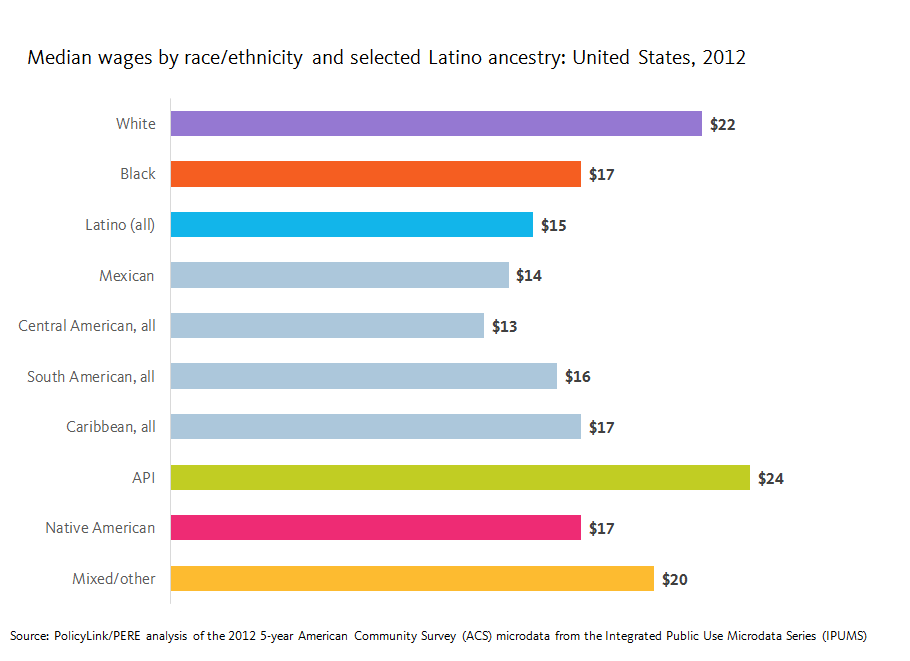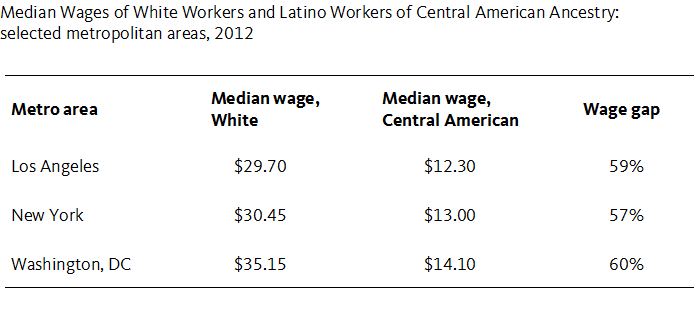Data by Ancestry Shows Wage Differences Among Latinos in the United States and Selected High-Cost Metros
In the United States, Latino workers earn the lowest median wages of any major racial group: just $15, compared with $22 for their White counterparts — a 32 percent difference. While these national measures bring into focus one of the most significant racial wage gaps in the country, they also obscure differences that exist within the broader Latino population as well as regional differences in wages and cost of living.
On May 23, PolicyLink and the USC Program for Environmental and Regional Equity added new ancestry breakdowns to six indicators in the National Equity Atlas. This is the third in a series of analyses of the new data, examining the “median wages” indicator for Latino workers.
Latinos Are Paid Significantly Less than Workers in Other Racial Groups – And Central Americans Tend to Be Paid Least of All
Among all U.S. workers, Asians and Pacific Islanders earn the highest median wages ($24), followed by Whites ($22), other/mixed race workers ($20), Blacks ($17), Native Americans ($17), and Latinos ($15). Yet as new data in the National Equity Atlas shows, average pay ranges widely within each of these groups. Among Latino subgroups, workers of Panamanian, Venezuelan, Chilean, and Argentinian ancestry earn the most – $19 per hour – while those of Guatemalan and Honduran ancestry earn an average of just $12 per hour. As the chart below illustrates, workers of Caribbean and South American ancestry tend to earn more than the average Latino worker, while those of Mexican and Central American ancestry tend to earn less than other Latinos.

Low Wages Persist for Central American Groups Even in Highest-Cost Regions
As the data in the Atlas shows, wages tend to vary widely by region due to local economic conditions. To take a closer look at differences in pay within the Latino community, we examined median wages in the 25 U.S. metros with the highest cost of living, measured by something called “regional price parities" (or RPPs). Calculated by the U.S. Department of Commerce, Bureau of Economic Analysis, RPPs indicate relative differences in the cost of goods and services across states and metropolitan areas. They are expressed as a percentage of the average national price level. For example, the most expensive U.S. metro in 2013 was Honolulu, HI, with an RPP of 122.5, while the least expensive was Beckley, WV, with an RPP of 78.
On average, the highest cost metros have the highest median wages; yet they also have staggering levels of wage inequality. The table below compares the wages of non-Hispanic White workers with their Latino counterparts of Central American ancestry in the three metro areas with the largest Central American populations: Los Angeles, CA; New York, NY; and Washington, DC. These three regions also happen to be ranked among the top 10 most expensive metros in the country.

In the Los Angeles metro area, Latino workers of Central American ancestry earn a median hourly wage of $12.30 compared with $29.70 for their White counterparts, representing a wage gap of 59 percent. In the New York metro, the median wage for Latinos of Central American ancestry is $13.00 compared with $30.45 for White workers, resulting in a wage gap of 57 percent. The wage disparity is even greater in the Washington, DC region, where Central American Latinos earn a median wage of $14.10 but White workers earn $35.15, making the racial wage gap between these groups a staggering 60 percent.
These differences are partly reflective of vast disparities in educational attainment between these groups. In Los Angeles, just 12 percent of Central American Latinos have earned at least an associate’s degree, compared with 57 percent of Whites; in New York, 14 percent of Central American Latinos compared with 58 percent of Whites; and in Washington, DC, only 11 percent of Central American Latinos compared with 69 percent of Whites.
Wages Vary Widely Both Among and Between Racial Groups
Los Angeles is home more than 718,000 Latinos of Central American ancestry — the largest such population in the United States. The graphic below illustrates the median wages of the six major racial groups in the Los Angeles metro region, as well as disaggregated data for Latinos. As the chart illustrates, the median wages of Central Americans trail not only other racial groups, but other Latinos as well. Workers of Guatemalan ancestry in Los Angeles earn an average of $11 per hour; Salvadorans, $12; Hondurans, $11; Nicaraguans, $15; and Costa Ricans, $19. Among Central American workers in Los Angeles, only those of Costa Rican ancestry earn higher average wages than Latino workers in general.

Disaggregated Data Critical to Developing Regional Inclusive Growth Strategies
We know that America’s future economic strength will depend on growing good jobs and ensuring that all workers — regardless of race, gender, or zip code — have access to stable employment with family-supporting wages and benefits. Latinos are the fastest-growing group in the United States, so ensuring that they are paid a fair, living wage is not only essential to family economic security but also to the vitality of our regional and national economies.
The new data on the National Equity Atlas highlight the need for disaggregation when developing strategies to address economic inequity, from targeted economic development and workforce efforts to worker organizing. By developing a clearer picture of the groups and communities struggling to make ends meet through low-wage work, advocates and policymakers can tailor their support to those who need it most.